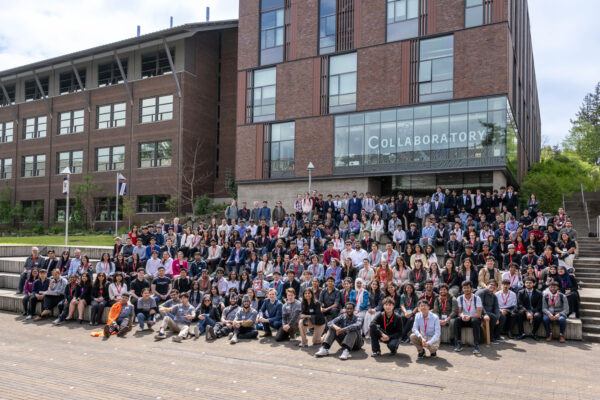For more than 30 years, Dr. Dan Jaffe has spent his career researching outdoor air pollution and its many sources — from wildfires to fossil fuels. In recent years, however, his curiosity has shifted inward as he looks to answer the question: “How clean is our indoor air, really?”
Jaffe, a professor in the University of Washington Bothell’s School of STEM, first began thinking about indoor air quality during the 2018 wildfire season, when a staff member said they could smell smoke inside. Jaffe, too, noticed he could smell it. Together with then-student Alex Margarito (Chemistry ’19), Jaffe walked around campus with a pollution sensor.
The pair made a startling discovery: The air inside was almost as bad as the air outside.
“That really got me thinking about what to do and how to improve the air inside,” he said. “We spend most of our time indoors. We’ve put a lot of effort into looking into the air outside and much less time looking at the air inside. It turns out, there are some important sources for indoor pollution.”
In his latest research, Jaffe wanted to find out just how high the presence of some of these pollutants was inside people’s homes. He presented his findings from the study, “Impacts of Freeways, Cooking and Wildfires on Indoor Air Quality in a variety of WA households: Toward Actionable Solutions,” in a Husky Highlights Seminar Series presentation last month.
A kitchen mystery
Jaffe’s curiosity about indoor pollution began with wildfire smoke, but he soon became concerned about other pollutants when his sensors indicated high levels of particulate matter during days when the air quality outside was in the healthy range. Cooking seemed a likely possibility.
He was also aware of recent information in the media about the dangers of gas stoves but could find little data on what emissions were like inside the home.
So with funding from UW Bothell’s Scholarship, Research and Creative Practice Grant program, Jaffe began work on the study with support from Dr. Brandon Finley, assistant teaching professor in the School of STEM, and Amelie Creekmore, an undergraduate student studying Chemistry.
“I get really excited about this work because it’s a nascent field. There’s so much to find, and you rely on people to take that jump,” Finley said. “I’m a big fan of applied science and always interested in that next start because I think the beginnings are where you learn the most, compared with more established areas of study that see incremental discoveries.”
The team’s first objective was to evaluate different low-cost sensors to find a suitable one for use in a volunteer home study. While their scope of research initially included pollution from freeways, they soon discovered the sensors weren’t sensitive enough to accurately detect indoor levels and limited the study to particulate matter and gases found in the kitchen.
A surprising find
In the first phase of the research, the team studied Jaffe’s own kitchen by sealing it off with plastic and turning the stove and oven on in 15-minute increments. Gas stoves produce high concentrations of carbon monoxide, carbon dioxide and nitrogen dioxide. Their findings confirmed levels well beyond healthy levels according to the Environmental Protection Agency’s Air Quality Index for outside air. Lacking an official standard for indoor air quality, they used that AQI as a standard.
Next, the team left a sensor in Jaffe’s kitchen over the course of a month, as he and his wife cooked and went about their typical routines. Again, the levels were above what is considered healthy.
As they moved onto the volunteer phase of their study, the researchers identified 17 volunteers who signed up through Jaffe’s blog and shipped each of them a sensor plus instructions for installation, how to log cooking times and whether any mitigation (such as fans or open windows) was to be used when cooking.
The study participants reported a wide variation in results. This, Jaffe explained, could likely be accounted for by the types of cooking people did — such as baking, boiling, frying, etc. — and how often they cooked. But like Jaffe found in his home, some participants also saw unhealthy levels of the pollutants.
The most surprising finding, however, was the amount of nitrogen dioxide recorded.
“In outdoor air, nitrogen dioxide has been greatly reduced because we’ve installed catalytic converters on cars, but even low levels of nitrogen dioxide account for a lot of responsibility for things such as asthma,” Finley said. “There’s this idea that you’re safe in your home, but it’s probably not as clean as we think.”
Actionable solutions
As with any new research finding, raising awareness about an issue is an important first step, Jaffe said. But the team also hopes to provide actionable solutions people can take to mitigate health risks.
The study found that using a fan or opening a window reduced the level of both the gas pollutants and particulate matter. In earlier research, Jaffe also discovered that even low-cost air purifiers are effective at removing particulate matter from the air. One of the most cost-effective solutions, he noted, turned out to be a box fan with a MERV 13 air filter attached to it.
Updating the range fan above the oven is another option — and both Jaffe and Finley noted that they now plan to replace their own range fans. Replacing a gas stove with an electric one is, of course, another way to reduce indoor pollutants from cooking. As there isn’t currently a filter available that removes gases from the air, this is also the only way to eliminate gas pollutants.
Dr. Rachel Scherr, assistant professor in the School of STEM and a participant in the study, said she plans to replace her gas stove with an induction electric stove and install a ventilation system.
“We learned that the air quality in our kitchen is very bad when I cook, and I cook a lot. Apparently, we have been living with over an hour every day of significant pollution in our kitchen,” Scherr said. “The study is the only reason we undertook the kitchen remodel. It’s a large expense and a lot of effort in the case of our particular kitchen setup, but we feel it is very important.”
The design of a home has a significant impact as well, Jaffe said, noting that “Dilution is the solution.” Home layouts with a more open floor plan that allows for molecules to spread out are going to have a lower exposure risk.
“We should be doing everything we can to reduce our use of natural gas from a climate perspective but also, as we now know, from a human health perspective,” Jaffe said. “Gas stoves in kitchens are definitely hazardous.”
We should be doing everything we can to reduce our use of natural gas from a climate perspective but also, as we now know, from a human health perspective. Gas stoves in kitchens are definitely hazardous.
Dr. Dan Jaffe, professor, School of STEM
Future considerations
The data from this study provide a lot of insights, but results also leave the team with more questions. Jaffe said he wants to continue the study with a larger batch of volunteers, and if given the opportunity to do the study again, he said he would take a closer look at the impact of fans and different types of cooking done by each of the participants.
As there isn’t currently a filter that would remove the gas pollutants, he also would consider what other actionable solutions could be used. He plans to test the viability of charcoal filters later this year, although he suspects that these, too, will be ineffective for removing gases.
This and other studies can raise public awareness about how polluted indoor air may be, Finley said, yet they do not mean that people should panic.
“While there are significant risks here, this is something we can slowly improve over time,” he said. “By taking this knowledge, you can design your houses better, use filters and take other actionable steps at mitigation. There are things you can do that are in your control. Gases, of course, are a little harder — but that’s a solution to come down the road.”



